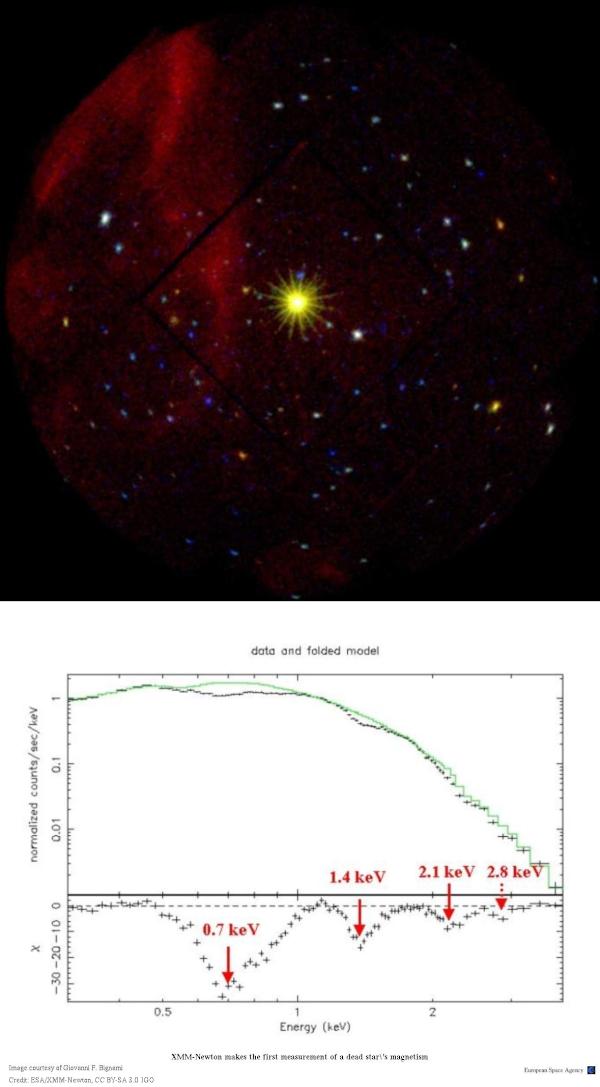XMM-Newton makes the first measurement of a dead star's magnetism

Minimum credit line: Image courtesy of Giovanni F. Bignami and ESA. (for details, see Conditions of Use).
Credit: ESA/XMM-Newton, CC BY-SA 3.0 IGO
The image above can be displayed at full size and may be downloaded by clicking the image above.
| About this Image |
|---|
The image shows the isolated neutron star 1E1207.4-5209 as seen by XMM-Newton's EPIC cameras. The top panel shows a false-colour image of 1E1207.4-5209 (yellow, central star) and the field of view around it, and the bottom panel shows its spectrum.
A neutron star has the mass of the Sun but a diameter of only 20-30 km, making it an extremely dense object. It is the result of a supernova, in which the outer layers of the star are ejected into space, and just a collapsed, dense ball of neutrons spinning extremely fast remains. Neutron stars cool down quickly and hence can only be seen in the X-ray for a limited time after the supernova explosion,
meaning only a few neutrons stars can be observed with X-ray telescopes like XMM-Newton. Normally the magnetic fields of neutron stars are measured indirectly, using theoretical assumptions about gravitational collapse and
radio measurements of their spin period. In this case, it was possible to observe 1E1207.4-5209 using the longest galactic observation ever performed by XMM-Newton of 72 hours, and its magnetic field strength was directly measured.
The spectrum of the neutron star shows cyclotron lines, visible in the spectrum at 0.7, 1.4, 2.1 and 2.8 keV. Cyclotron lines result from the spiralling of charged particles around magnetic field lines. The accelerated particles emit radiation at specific frequencies which can be used to derive the magnetic field strength. The derived field strength for 1E1207.4-5209 was 30 times weaker than had been predicted based on the indirect methods. It is also incompatible with the field which was derived from timing parameters. This result suggest some other mechanism may be slowing the neutron star down, discussed further in the online references. It is hoped that more neutron stars will be observed with XMM-Newton in order to see if 1E1207.4-5209 is unique or if other neutron stars can be observed to have similar characteristics.
Investigator(s): G. F. Bignami, P. A. Caraveo, A. De Luca & S. Mereghetti
| For More Information |
|---|
- Read the Press Release
- Read the Journal article
- Visit related website;
http://www.esa.int/esaCP/SEM1E0T1VED_index_0.html - Detailed description of this image
- Query XSA archive for XMM-Newton data in the field of 1E1207.4-5209
- Astronomical database entries for 1E1207.4-5209;
- Query NED for more images about 1E1207.4-5209
- Query SIMBAD for more 1E1207.4-5209 data
- For unfamiliar terms, visit the XMM-Newton Astronomical Glossary
| Alternate Resolutions | (Help) |
|---|
This image is available in the following downloadable versions: Higher resolution versions of this image may be available, please contact the XMM-Newton HelpDesk.
Search the Image Gallery
To search the Image Gallery for a particular object, fill in the object name in the box below and click the Submit button.To search the Image Gallery for other images, fill in any of the fields below and click the Submit button.
For more search options, please use our Advanced Search form.